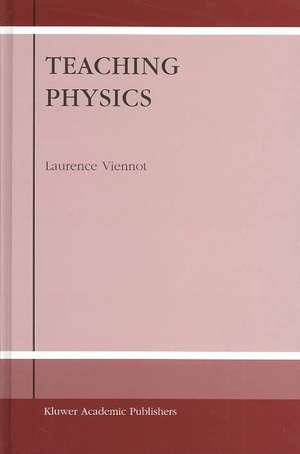Teaching Physics
Autor L. Viennoten Limba Engleză Hardback – 30 iun 2003
| Toate formatele și edițiile | Preț | Express |
|---|---|---|
| Paperback (1) | 710.63 lei 6-8 săpt. | |
| SPRINGER NETHERLANDS – 30 iun 2003 | 710.63 lei 6-8 săpt. | |
| Hardback (1) | 644.95 lei 6-8 săpt. | |
| SPRINGER NETHERLANDS – 30 iun 2003 | 644.95 lei 6-8 săpt. |
Preț: 644.95 lei
Preț vechi: 758.77 lei
-15% Nou
Puncte Express: 967
Preț estimativ în valută:
123.41€ • 129.20$ • 102.11£
123.41€ • 129.20$ • 102.11£
Carte tipărită la comandă
Livrare economică 05-19 aprilie
Preluare comenzi: 021 569.72.76
Specificații
ISBN-13: 9781402012754
ISBN-10: 1402012756
Pagini: 256
Ilustrații: XV, 235 p.
Dimensiuni: 170 x 244 x 19 mm
Greutate: 0.54 kg
Ediția:2003
Editura: SPRINGER NETHERLANDS
Colecția Springer
Locul publicării:Dordrecht, Netherlands
ISBN-10: 1402012756
Pagini: 256
Ilustrații: XV, 235 p.
Dimensiuni: 170 x 244 x 19 mm
Greutate: 0.54 kg
Ediția:2003
Editura: SPRINGER NETHERLANDS
Colecția Springer
Locul publicării:Dordrecht, Netherlands
Public țintă
ResearchCuprins
1 / Watersheds.- 1. How and What to Spotlight.- 2. How Much Should be Explained.- 3. Images: Are they always useful?.- 4. Experiments: Are they supposed to help?.- Appendix 1: Some General Intentions Are Very Similar in the Various Syllabuses.- Appendix 2: Why the Pinhole Camera is no Longer on the Syllabus.- 2 / Contact, friction and propulsion.- 1. Laws that Run Counter to Common Sense.- 2. A Method of Spotlighting the Basics.- 3. A Way of Spotlighting Friction: goals and difficulties.- 4. First Elements of Static Friction: step by step.- 5. Analysing the Sequence: lines of attention.- 6. Evaluation of the Sequence with Students.- 7. Reactions of Trainee Teachers.- 8. What Conclusion Should We Draw?.- Appendix 1: The Technique of Fragmented Diagrams.- Appendix 2: Two Situations for Studying Kinetic Friction.- Appendix 3: Trainee Teachers’ Comments on the Sequence.- 3 / Pressure in Fluids in the Presence of Gravity.- 1. Questions About the Merits of a Microscopic Approach.- 2. The Macroscopic Level: what quantities “have to be”?.- 3. Fluid Statics: common ideas among students.- 4. A Proposal for the Teaching of Fluid Statics.- 5. Analysing the Sequence: lines of attention.- 6. Evaluation of the Sequence with Students.- 7. Teachers’ Reactions.- 8. Conclusion.- Appendix: Main Results of the External Evaluation.- 4 / Superposition of Electric Fields.- 1. Interaction at a Distance and Superposition.- 2. Charges, Fields and Superposition: selected aspects.- 3. Superposition and Causality: common forms of reasoning.- 4. Elements of a Teaching Sequence.- 5. Analysing the Sequence: lines of attention.- 6. Evaluation of the Sequence.- 7. Conclusion.- Appendix 1: Contents Previously Taught to Students Questioned in the Preliminary Survey.- Appendix 2: Electrostatics andElectric Circuits Disconnected: the field in wires.- 5 / Superposition of Waves and Optical Imaging.- 1. Choosing a Model.- 2. Common Difficulties and “Spotlighting” of the Content.- 3. Analysing the Proposal: some elements.- 4. Reactions of In-Service or Trainee Teachers.- 5. Conclusion.- 6 / Colour Phenomena.- 1. A Topic at a Crossroads.- 2. Colour Phenomena and Light: the chosen approach.- 3. Common Ideas: too exclusive a linkage.- 4. A Proposed Sequence.- 5. More Detail, Following the Lines of Attention.- 6. Evaluation of the Sequence.- 7. Teachers’ Reactions.- 8. Conclusion.- Appendix 1: Additive and Subtractive Mixing.- Appendix 2: Aspects of Knowledge Whose Acquisition is Evaluated One Year after the Sequence.- Conclusion.- Index of Names.
Caracteristici
Includes supplementary material: sn.pub/extras

